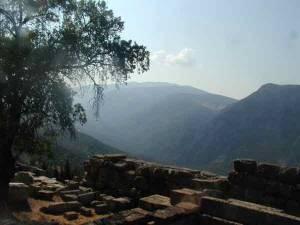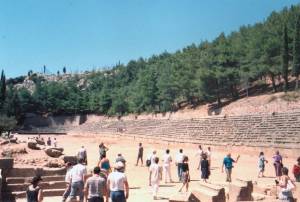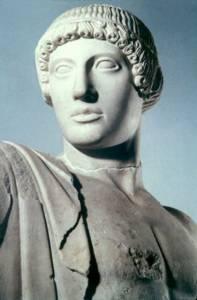Delphi: The Archaeological Site and the Museum
 The Archaeological Site The Archaeological Site
The archaeological site of Delphi, in a terrain that only the gods could have devised, is one of the most important ancient relics of Greece. The magnitude of the Delphi contribution to all of ancient civilization cannot be overstated.
The first excavations here began in 1838 and were completed in 1935. The Sanctuary of Apollo with the Treasuries (buildings where the city-states kept votive offerings and religious vessels), the temples, and the peribolos (enclosure) lie on the south flank of Mt. Parnassos, to your right if you are coming from Arahova. The center of the Sanctuary is dominated by the Doric Temple of Apollo.
The Sacred Way leads to the Temple and is lined with Treasuries, monuments and offerings. Northwest of the Temple is the theater with 5,000 seats, where the Delphic Festivals were held, which had as a central theme the representation of Apollo's victory over the serpent Python. Rather further to the west, and somewhat above the theater, lies the Stadium where the Pythian Games took place every four years. offerings. Northwest of the Temple is the theater with 5,000 seats, where the Delphic Festivals were held, which had as a central theme the representation of Apollo's victory over the serpent Python. Rather further to the west, and somewhat above the theater, lies the Stadium where the Pythian Games took place every four years.
To the right of the entrance to the Sanctuary is the Kastalian Fountain, where Pythia washed before speaking her prophecies, and on the left and below the road stands the Sanctuary of Athena; finds have shown that it had been dedicated as early as the Mycenaean era to a female deity. The tholos or rotunda, one of the most remarkable architectural constructions of antiquity, stands next to it. It is not known what this building was used for.
For a photographic tour of the Delphi Archaeological Site please click HERE

The Museum
The Museum of Delphi is considered among the three most important museums in Greece, together with the ones of the Acropolis of Athens and in Heraklion, Crete. What makes a visit to the Greek Museums in general, this one in particular, an unforgettable experience, is the fact that they usually exist on the very archaeological site(s), thus putting the exhibits in the surroundings in which they were initially established, in close relevance to their cultural and/or religious role.
The first museum of Delphi was built in 1903 on the plans of the French architect Tournaire, and was later incorporated in a larger edifice constructed in 1938. The rearrangement of the exhibition was carried out gradually and was finally completed in 1980. A new room was added in 1974 for the exhibition of the gold and ivory finds from the sanctuary. A project for the further enlargement of the museum, which has improved the display of the finds, as well as the appearance of the building, has already been realized by the Ministry of Culture, with the museum now featuring bioclimatic methods of lighting, windows with “invisible” panes, and trail-blazing fragment preservation and reassembling; for this reason it was kept closed for nearly one year.
This ground floor museum, as already mentioned, is actually an integral part of the sanctuary and, in its 13 Galleries, it houses some very important sculptures from Archaic, Classical, and Hellenistic Greece, including the Navel of the World (a Hellenistic or Roman copy of the Sacred Stone); the Sphinx of the Naxians (550 BC); the statue of Antinoos; the statue of Aghias; the group of Thyiads (three colossal female figures portrayed seemingly dancing around a flowered column from the Sanctuary of Dionysus-this 'dance' is an older belief not accepted by recent research); the Metopes from the Treasuries of Sicyon and Athens; the Karyatid and Zephyr from the Treasury of Siphnos; the Head of Dionysus; pottery; more figures and friezes from the various treasuries; the two Kouros statues known as Kleovis and Biton; gold and ivory offerings from the Sanctuary and, above all, the Charioteer of Delphi, now given the luxury of occupying a whole gallery of his own. Actually, the wealth of this museum makes a Guided Tour indispensable.
For a photographic tour of the Delphi Archaeological Museum please click HERE |
|



